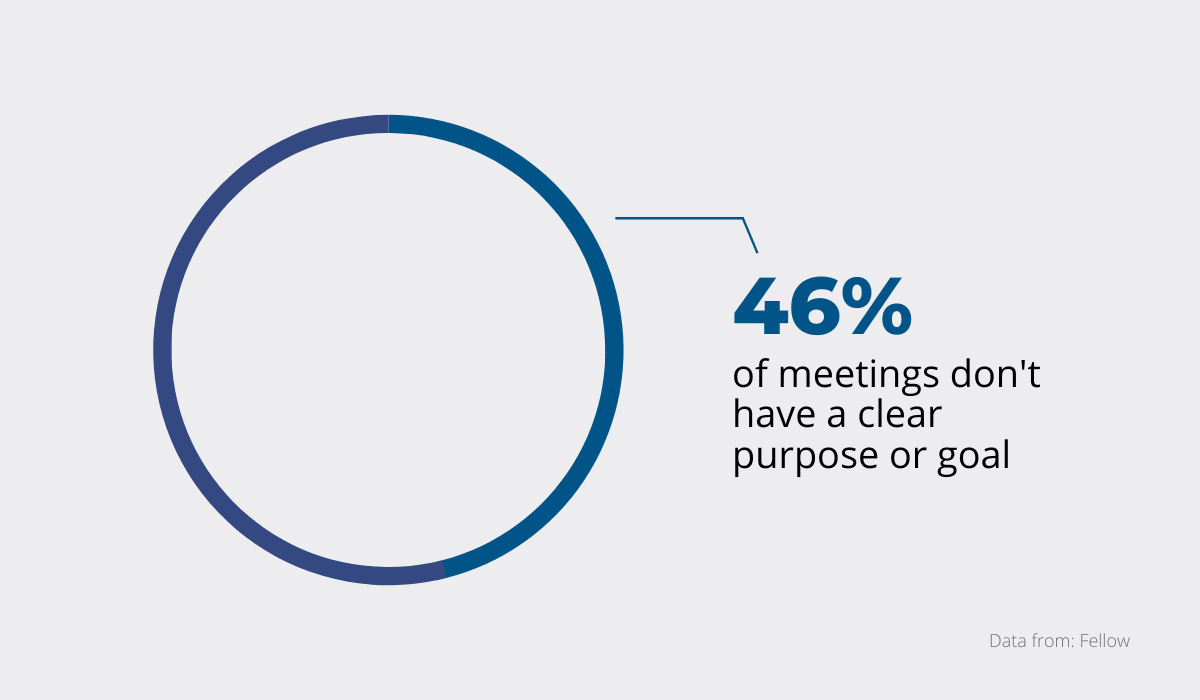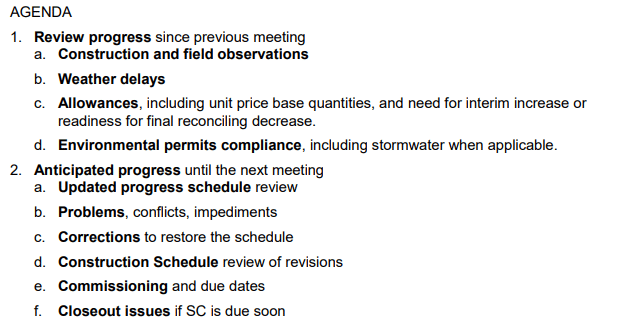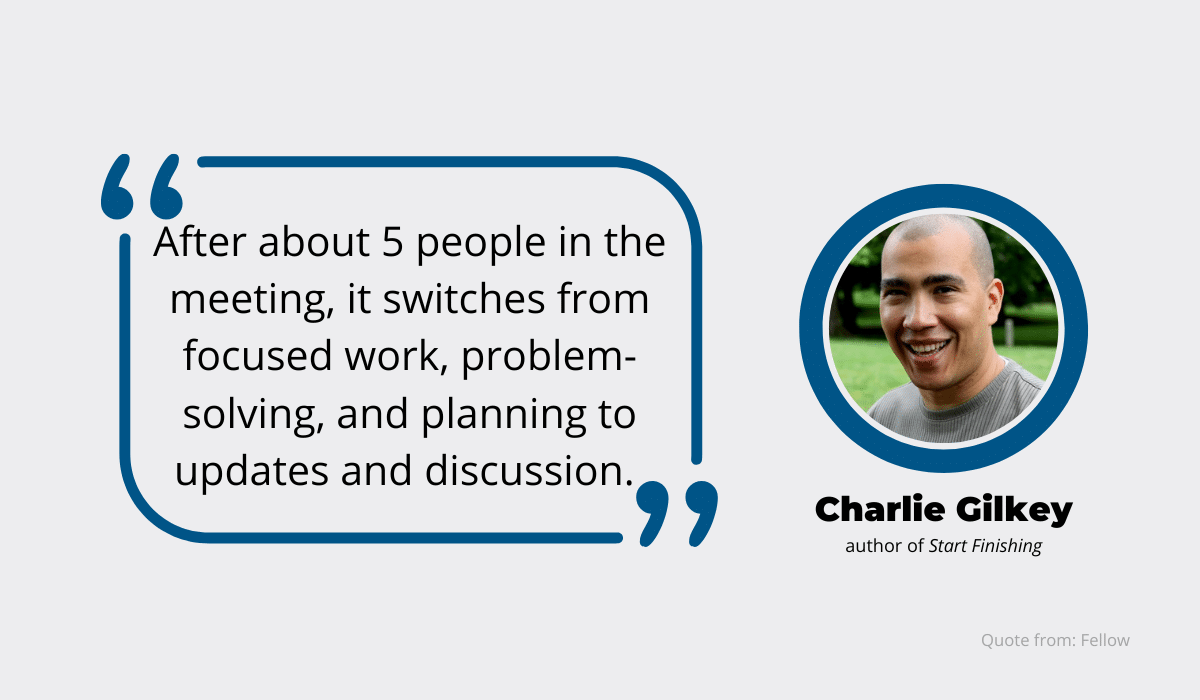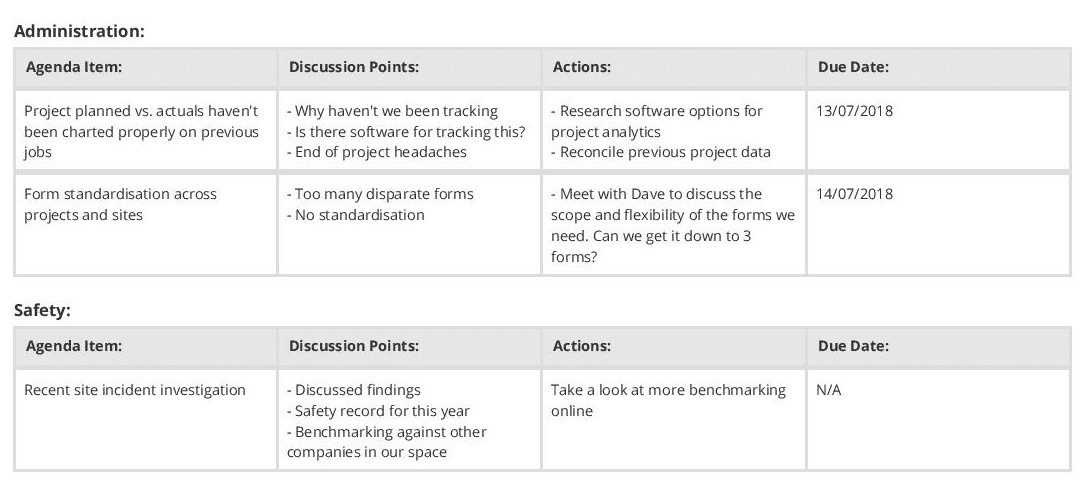Imagine the following situation. You are attending a meeting, but there are more people than necessary at the meeting, so some don’t even contribute.
The project managers are speaking from memory instead of using real-time data. Once the meeting ends, you realize no one took notes.
What we’ve described is a meeting that probably took place without an agenda.
Does this awful scenario happen at your company? If any part of it does, it’s time to change something fast.
In a construction company, meetings can determine whether a building project succeeds or fails.
You can use them to practice teamwork, brainstorming, detecting challenges, and finding the best solutions.
Here’s what you need to know to optimize your meetings!
In this article...
Decide on the Type of Meeting That Suits You Best
Determining the type and the purpose of your meeting should be the first step you take when planning to call a meeting.
After all, the attendees have to know what to expect and how to prepare.
Going to a strategic planning meeting is different from attending a feedback meeting, so your team must understand what you have in store for them.
To help you figure out the terminology, here are some of the most frequent types of construction meetings and their purposes.
Type of Meeting | Purpose |
|---|---|
Strategic planning | Creating a strategy for the upcoming period, set targets and goals based on last year’s results |
Monthly/weekly strategy | Comparing your current state with the goals set during the annual meeting |
Project update | Checking the progress of the project(s) and seeing how it lines up with the set schedules and goals, make adjustments to the project plan where necessary |
Superintendents and foremen | Understanding the progress, goals, schedule, activities, equipment condition, and employee performance |
Kickoff | Ensuring all stakeholders are on the same page |
Of course, these are only some of the many types of meetings you can organize that fit your current construction project needs.
Remember that meetings are there to help you keep yourself and others accountable.
Once you announce the type of meeting, the team will be able to come prepared, with the right report ready for you.
As a result, you’ll stay in the loop and be able to recognize potential issues before they escalate.
In short, deciding on what you aim to achieve will determine the type of meeting you’ll organize, which will in turn help the team get ready accordingly.
Prepare a Clear Meeting Agenda
Setting an agenda ensures that you stay on topic and accomplish what you set out to do.
Without a set meeting plan, you could easily change subjects and talk about something that isn’t as urgent as the issues at hand.
Attendees could bring up things unrelated to these issues, which could derail the conversation.
Despite these apparent problems, research by Fellow has found that many meetings are still conducted without a clear goal.

A meeting without a purpose won’t help you get anything done as you will easily get distracted from the main topic.
That’s why it’s vital to understand why you even want to hold this meeting in the first place. What do you need to discuss with the team? Why is it important?
You can write down your construction meeting agenda when you figure out these steps. List the points you want to discuss and dedicate a time slot for each main topic.
That way, you’ll stay on track and on time.
Here’s an example of a construction meeting agenda.

The plan clearly shows what points to discuss during the meeting, including the progress made since the last meeting and the progress to make until the next one.
You can set up your plan differently, as long as it lists every point you will cover during the meeting.
Once you have a good schedule, send it to the team members who will attend the meeting ideally a week before it happens.
That way, your workers will have ample time to prepare for the discussion. Some might have questions, and others could bring some relevant data you didn’t think to include.
But, this won’t happen if you don’t share the plan beforehand.
Creating and sticking to a meeting schedule will help you discuss everything you planned, ensuring you reach your goals.
Include Only the Key Stakeholders
If you’ve ever been to a meeting where you weren’t actually needed, you know how embarrassing and sometimes frustrating it is to waste your time listening to a discussion you can’t contribute to.
To avoid this problem the next time you and your employees convene, make sure your list of attendees is carefully thought-out.
It is important that those who participate get invited because their ideas or input are necessary for at least one of your agenda items.
Charlie Gilkey, the author of Start Finishing, says that you should limit the number of people at the meeting.
Gilkey believes that inviting more than five people can make what would otherwise be a productive meeting dissolve into a series of discussions where everyone is updating each other on unnecessary details instead of working on the agenda.

Therefore, try to limit the number of attendees as much as possible and include only the most essential personnel.
If you have difficulty deciding who to invite, follow Gilkey’s advice and “consider why they don’t need to be there.”
In other words, if you find reasons why a person shouldn’t be at the meeting, don’t invite them.
For example, if your meeting is about construction equipment, you’ll probably need someone from the maintenance team there to talk more about the current state of your construction fleet.
But, if the meeting deals with project planning on a larger scale, there’s a chance the maintenance department won’t have much to add.
So, once you understand the topics you must cover, see who can help you brainstorm or implement the ideas.
You need people with the insights and knowledge necessary to help you make the right decisions and find solutions.
Creating a list of attendees will help you determine who can contribute to your meeting.
As a result, you won’t waste someone’s time by inviting them to a meeting they won’t be able to contribute to due to a lack of expertise.
Leverage Technology Data During the Meeting
Construction technology can be one of the essential aspects of your meeting, almost like an attendee in its own right, if you know how to leverage the data it provides.
Let’s imagine you have a meeting about construction equipment. You need to decide on a budget for the construction fleet, so you need help from experts.
Your maintenance team claims you need to invest in a crane because the one you have is always out in the field due to high demand.
But, if you use equipment tracking software like GoCodes Asset Tracking, you can also extract the data the software collected to verify the maintenance team’s claims and point to the best course of action.
You can use the reporting function to find out details about your equipment.

For example, the software will show you exactly how many times a piece of equipment has broken down and how much you’ve spent on its maintenance.
With information like this, it will be much easier to decide whether to sell some gear and invest in newer tools that could get the job done without needing so much upkeep.
Tool tracking software like GoCodes Asset Tracking will also show you which equipment you haven’t used.
If you have ten bulldozers but only ever use five at a time, you’ll find out through a usage report. In that case, it might be wise to sell some of the bulldozers and buy those cranes you need.
Therefore, software like this simplifies decision-making regarding equipment, which is a huge part of the construction business.
Using the tracking software reports during meetings will help you base decisions on real-time facts and not educated guesses.
Take Notes
Note-taking is nothing new, yet many companies fail to implement the practice in their meetings.
Do you have a person in charge of taking meeting minutes?
If you do, you know it’s a relief to have an overview of the most critical ideas, solutions, and propositions that you can send to attendees after the meeting.
However, Fellow also found that most companies still rely on individual notes, which means there is no single source of truth and no standard document that everyone has to follow.

Not having a verified document everyone can access leads to multiple versions of meeting notes and potentially incorrect or lacking information spreading around.
So, always appoint someone as a note-taker during meetings.
With readily available notes, the team won’t forget what you discussed and what steps they should take.
Besides, when sending an invite for the next meeting, you can include the meeting minutes from the last meeting.
These notes will refresh the team’s memory and ensure everyone is on the same page.
Sitemate offers a template for a construction meeting’s minutes, thus helping those who aren’t sure which format to choose.

They suggest going through each agenda item, making a note of the discussion points and writing down the actions to take along with the due date.
This format might not work for all meeting types, but you can look into it and find points you can use for your meeting minutes in the future.
Plan.io gives some great advice on taking notes during meetings, including offering different note-taking methods. The two methods they cover are the Cornell and Quadrants methods.
The former leaves less room for meeting details and summary while placing more importance on critical points and notes on them, such as discussion, action items, and the like.

The quadrants method means splitting your document into quadrants where you will write questions, notes, action items for yourself, and action items for others.
The method assumes that each of these points deserves the same attention.
No matter the format or method, write down the essential topics you’ve covered in the meeting.
End With an Action Plan
When a meeting ends, everyone should leave with a clear idea of what should happen next.
In other words, end your meeting with a plan for what everyone should do and when. If another meeting is needed, you should discuss it at the end of the current one.
Before leaving the meeting, collaborate and determine who gets which tasks and when you are meeting next to discuss progress. This is where your meeting notes will come in handy.
The person in charge of note-taking should write down each potential action so you can easily assign a task to one of the attendees.
According to Plan.io, an action item answers the questions who, what, and when.
In other words, an action is complete only when you understand the answers to these questions.
The who of an action item relates to the person in charge of it, but also the people who will work on the task.
The what will give more details on what these individuals need to accomplish and the when defines the deadline.

Plan.io also suggests using a project management app to turn these action items into tasks you can easily update and track.
When you keep track of your tasks, it will be easier to prepare data for the next meeting and keep your team in the loop.
Let’s go back to the earlier example of bulldozers and cranes. Your plan after that meeting will probably be to prepare the equipment and put it up for sale.
Some stakeholders should get these tasks and start tackling them after the meeting. Someone else should look into cranes and decide which model meets your current needs.
You should verbalize and assign these assignments to the team, turning them into action items on the spot.
After all, when your attendees leave the room or get off the call, they should know their next steps. Because of this, creating action items and understanding who is doing what is essential.
Conclusion
After a successful construction team meeting, your employees will understand the meeting’s main points, actions to take, and who will be taking them.
None of the attendees will feel like they shouldn’t have participated since everyone will have a role to play, whether presenting data, offering ideas, or being in charge of action items.
Finally, your meeting will end with creating a good action plan for the next one, with precise tasks assigned to the correct people.
Following this article’s advice, you can achieve all of this, starting with your next construction meeting.
What are you waiting for?









